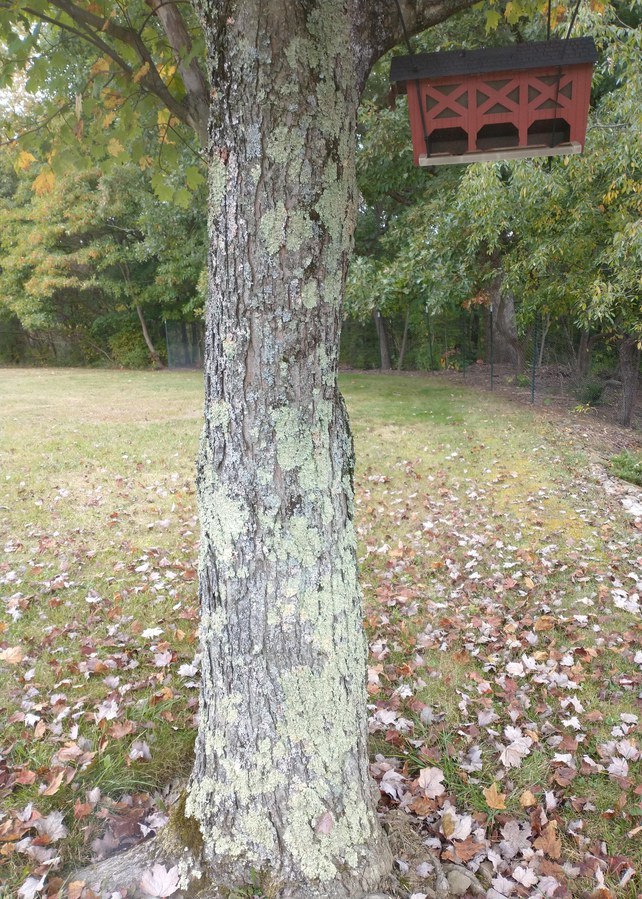Posted: May 4, 2024

Lichens on a tree trunk
By Mary Jane Busch, Pennsylvania Forest Steward, Class of '22
If you have crusty, scaly, blue-green patches on your trees, should you be thankful or concerned about their presence? If you consider this fungal-algal organism unsightly, should you remove it?
Those colorful splotches are lichens (pronounced “lie-kens”). These organisms are thallophytes, plantlike forms that lack true roots, stems, or leaves. The body is called a thallus and is two species living together in a symbiotic relationship. The major partner (80%), a fungus, determines its classification as a fungus. The secondary partner is either an alga or cyanobacteria (formerly called blue-green alga).
Because each of the partners benefits in the arrangement, the specific symbiotic term is mutualism. In the case of lichens, the relationship is obligate—neither the fungus nor the alga could survive without the other. The fungus cannot make its own food, so the alga photosynthesizes food for its partner. In return, the fungus provides protective housing and support for the alga.
Rhizines of the fungus attach the lichen to the outer surface of the tree, but these “roots” do not take nutrients from the tree or harm their host. As an epiphyte, also known as an “air plant,” the fungal outer coat absorbs moisture from rain, dew, or fog and collects minerals from the air. These photosynthetic ingredients are then transported to the alga to make food using sunlight.
There are at least 18,000 species of lichens, and they are found on every continent, including Antarctica. Some species have a narrow habitat range while others can colonize a variety of substrates. They can be found on tree bark, dead wood, rock, rusty metal, plastic, cloth, glass, bare soil—even sand dunes—just about any surface on which a fungus can survive. Colors can range from bright red to yellow, gray, green, blue, brown, or black.
In the northern tundra, lichens (a.k.a. reindeer moss or caribou moss) begin many food chains and are eaten by invertebrates and vertebrates, including lemmings, voles, mice, marmots, squirrels, polar bears, musk oxen, elk, and caribou. As much as 25% of the diet of caribou can be provided by these organisms. Indigenous peoples harvest and store the crop for winter feed for their reindeer (domesticated caribou) herds.
Hundreds of species of lichens colonize trees. The organisms live on healthy as well as unhealthy trees. Larger colonies are often found on stressed or older trees, and, because of this, lichens are often blamed for the tree’s decline. However, a “sick” tree generally loses foliage, and this thinning of the tree’s leaves allows more sunlight to reach the trunk. The algae is then able to make more food, and the lichen grows and becomes more noticeable. By this explanation, the cause-and-effect presence of lichens causing tree deterioration is debunked.
Each lichen species has its specific requirements. On tree trunks, pH is often a limiting factor; all species have an optimum range of bark acidity. As bark becomes less acidic with age, lichens move onto the older trunks with a “sweeter” habitat. Ash trees have a very high alkalinity and are hosts to over 500 different species of lichens. On the other end of the scale, acid rain lowers the pH and makes a tree’s trunk less suitable for lichens.
Although found around the world, lichens are not found where the air contains a lot of ozone, sulfur dioxide, fluoride, ammonia, or acid rain. Most lichens are very sensitive to air pollutants and are one of the first organisms to die when pollution increases.
In the 1860s, scientists discovered lichens thriving in areas with clean air but declining in areas with dirty air. Like canaries in the coal mine, various species have been used to monitor air quality. Because lichens have no protective epidermis, they imbibe both beneficial and detrimental airborne elements. Their deterioration can indicate sulfur dioxide emissions from industrial operations and drifting ammonia and nitrates from agricultural activities. Lichens also accumulate mercury from power plant emissions, lead and zinc from mining ore smelters, and radioactive metals. Elemental analysis of lichens can then be used to measure these health-impacting discharges.
What has been described as a lichen zone pattern occurs in urban areas and near industrial complexes. Where there are no lichens, there is poor air quality. Since the enactment of the Clean Air Act, sulfur dioxide levels fell from the 1970s to the 1990s, and lichens have reestablished in areas where they had perished.
Lichen presence on a tree trunk can be a double-edged sword. The fungal body can act as a natural sunscreen, protect tree trunks from physical damage, and seal off the entrance for pathogens into the bark. On the other hand, the cloak retains moisture and creates a humid microenvironment on tree bark. This additional moisture can mitigate drought periods for the host and lichen, but it can also create habitat for negative bacterial and fungal growth which could be harmful to the tree. However, dendrologists agree that removing lichens from a tree is destructive as it damages the bark and creates entryways for diseases and pathogens.
Lichens get a thumbs up as natural sentinels for the air that we breathe. Their number and diversity are a bioindicator of good or poor air quality. If you have lichens on your trees, your air quality is probably very good. You must also remember that lichens can be a red flag indicating poor tree health, not caused by them, but caused by other factors. As Scott Weikert, Penn State Extension Educator, says, “If you see a tree that appears to be in poor health or dying, don’t blame the lichens. The only thing they are killing is time.”
James C. Finley Center for Private Forests
Address
416 Forest Resources BuildingUniversity Park, PA 16802
- Email PrivateForests@psu.edu
- Office 814-863-0401
- Fax 814-865-6275
James C. Finley Center for Private Forests
Address
416 Forest Resources BuildingUniversity Park, PA 16802
- Email PrivateForests@psu.edu
- Office 814-863-0401
- Fax 814-865-6275

